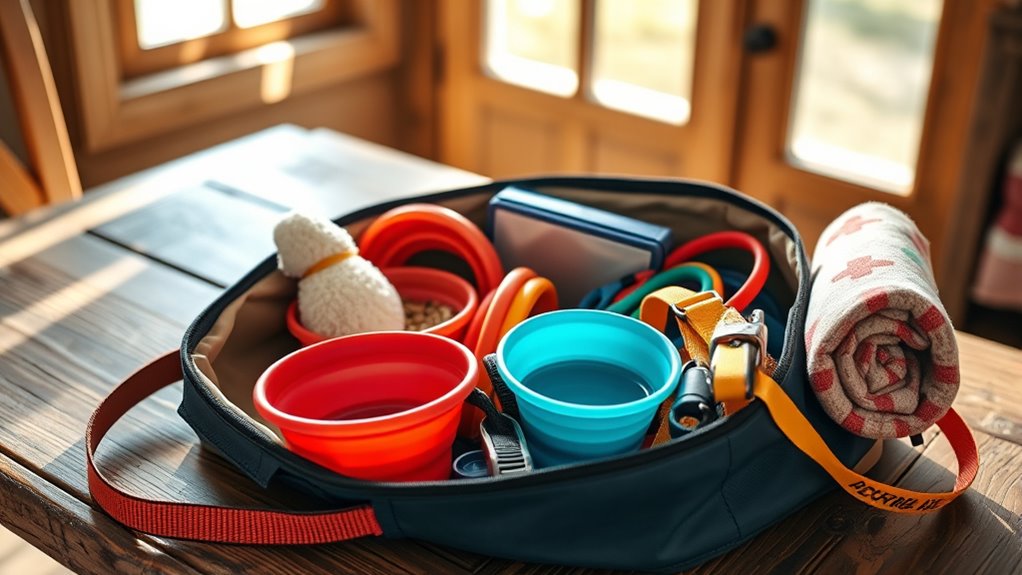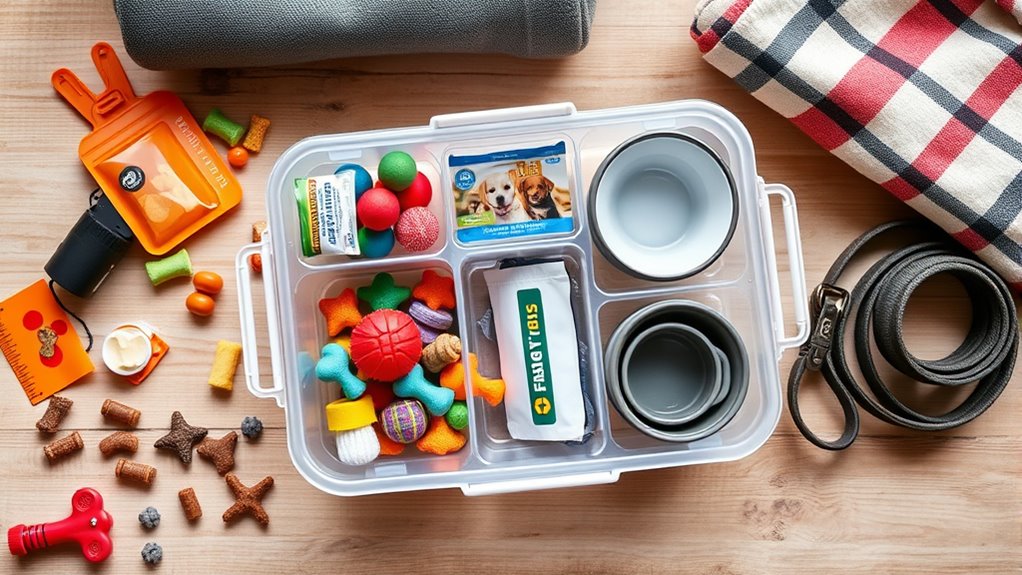To build a pet bug-out bag, gather enough food for at least three days, including dry kibble and canned or dehydrated options, and store it in a leak-proof container. Pack essential first aid supplies, prescribed medications, and comfort items like treats to keep your pet calm. Use proper storage techniques to keep everything fresh and safe. Continue exploring for a thorough checklist to ensure you’re fully prepared for emergencies.
Key Takeaways
- Pack at least 3 days’ worth of pet food, considering dietary needs and including dry, canned, or dehydrated options.
- Include treats and comfort items to keep your pet calm, and store them in sealed, accessible containers.
- Assemble a first aid kit with antiseptic wipes, gauze, medications, and a digital thermometer for health monitoring.
- Add any specific medications or supplies prescribed by your vet, ensuring they are labeled and easily accessible.
- Store supplies properly, regularly check and update contents, and replace expired items to maintain readiness.

When emergencies strike, having a dedicated bug-out bag for your pet can make all the difference. You never know when a sudden disaster might force you to evacuate quickly, and being prepared guarantees your furry friend stays safe and comfortable. One of the most vital aspects of your pet’s bug-out bag is emergency feeding. Pack enough food for at least three days, considering your pet’s size, dietary needs, and any special restrictions. Dry kibble is a good choice because it’s lightweight and has a long shelf life, but including some canned or dehydrated options can provide variety and guarantee your pet’s nutritional needs are met. Don’t forget a portable, leak-proof dish for feeding on the go, and consider adding some treats to keep your pet calm and comforted during stressful times. Staying prepared with emergency feeding can prevent panic, hunger, and dehydration, giving you peace of mind that your pet won’t go hungry when it matters most. Proper storage techniques can help preserve the freshness and safety of your pet’s food supplies during emergencies.
Another essential component of your pet’s bug-out bag is first aid supplies. Accidents happen, and having a well-stocked first aid kit can be lifesaving. Your kit should include items like antiseptic wipes, bandages of various sizes, gauze, adhesive tape, and tweezers. You should also include any medications your pet regularly takes, along with copies of their medical records in case you need to visit a vet unexpectedly. It’s wise to add some antiseptic ointment for cuts and bruises, as well as a digital thermometer to monitor your pet’s health. If your pet has specific health issues, be sure to include specialized supplies or medications prescribed by your vet. Having these first aid supplies on hand allows you to treat minor injuries immediately, prevent infections, and stabilize your pet until professional help is available. Remember, emergencies can happen anywhere—be it a minor scrape or something more serious—and having the right first aid supplies can make all the difference in ensuring your pet’s well-being.
Ultimately, an effective pet bug-out bag combines emergency feeding essentials and extensive first aid supplies, tailored specifically to your pet’s needs. Regularly check and update your kit, replacing expired items and adjusting for any changes in your pet’s health or diet. By doing so, you’ll be ready to respond swiftly and confidently in any emergency, giving your pet the best chance for safety, comfort, and quick recovery. Being prepared isn’t just about having the right items; it’s about knowing you’ve done everything possible to protect your beloved companion when the unexpected happens. Incorporating proper storage techniques can further enhance the longevity and safety of your supplies, ensuring they remain effective when needed most.
Frequently Asked Questions
How Often Should I Update My Pet Bug-Out Bag?
You should update your pet bug-out bag at least every six months to account for seasonal adjustments and changing needs. Check that food, water, and medications are fresh, and update pet identification tags. This guarantees you’re prepared for emergencies year-round. Regularly reviewing your bag helps you catch any expired items or outdated information, so you’re always ready to act swiftly and keep your pet safe during unexpected situations.
What if My Pet Has Special Medical Needs?
If your pet has special medical needs, you should include specific medical supplies like medications, prescriptions, and any necessary mobility aids in your bug-out bag. Keep these items up to date and easily accessible. You might also want to add detailed instructions for care, and guarantee your pet’s mobility aids are functional and ready to use. Regularly check and update these supplies to ensure you’re prepared for emergencies.
Can I Include Toys and Comfort Items?
Think of your pet’s comfort items as a lifeline in chaos. Yes, include toys and comfort items in your bag; they provide a calming anchor amid uncertainty. Choose toy selection wisely—soft, familiar toys or squeaky favorites help ease anxiety. Pet comfort items like blankets or a favorite plush create a sense of security. These small touches turn a stressful situation into a manageable one, making your pet feel safer and more at ease.
How Do I Pack for Multiple Pets?
To pack for multiple pets, organize each pet’s essentials in separate travel containers and include enough food for their feeding schedules. Label containers clearly and bring extra supplies like bowls, leashes, and medications. Keep their comfort items handy. Plan your packing so everything is accessible, and consider their specific needs, ensuring each pet feels secure and cared for during the emergency.
What Are the Best Storage Options for the Bag?
You should choose a sturdy, durable bag made of high-quality materials to withstand rough conditions. Look for options with reinforced handles and water-resistant fabric for added protection. To optimize space, select a bag with multiple compartments or adjustable dividers, allowing you to organize essentials efficiently. Consider a lightweight design so you can carry everything comfortably. This way, your pet’s supplies stay protected and accessible during emergencies.
Conclusion
Now, as you zip up your pet bug-out bag, imagine the quiet hum of your pet’s favorite toy tucked inside, ready for the journey. The bag feels like a small, sturdy fortress, holding everything your furry friend needs—food, water, comfort. When the time comes to evacuate, you’ll both step into the unknown, side by side, confident that your thoughtful preparation has turned a moment of chaos into a shared adventure, safe and secure.










